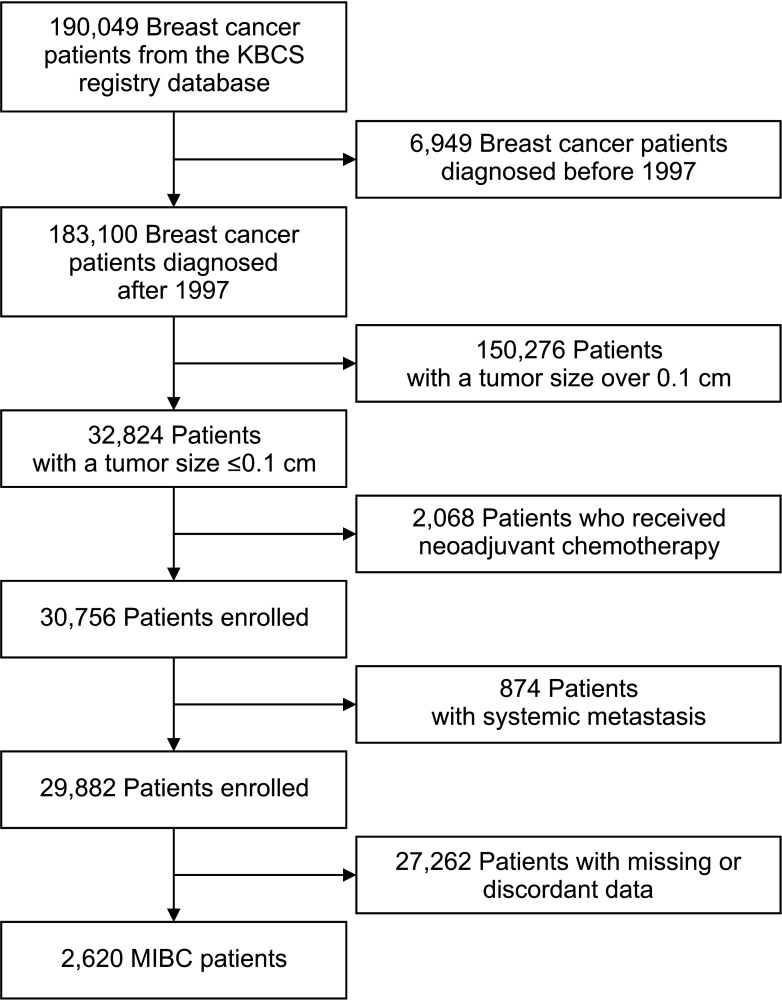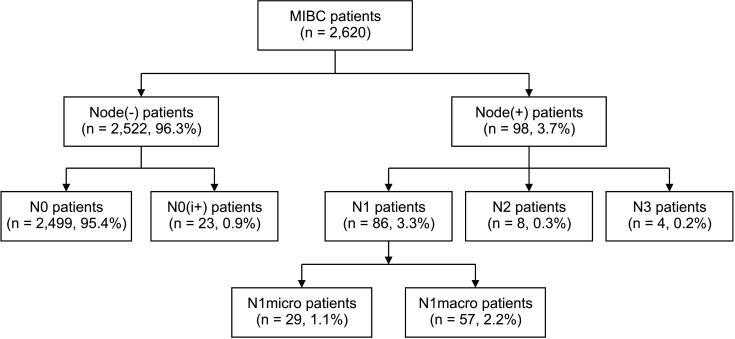Ann Surg Treat Res.
2022 Jun;102(6):306-312. 10.4174/astr.2022.102.6.306.
Low incidence of lymph node metastasis in patients with microinvasive breast cancer: a Korean nationwide study
- Affiliations
-
- 1Department of Surgery, Bucheon St. Mary’s Hospital, Bucheon, Korea
- 2Department of Surgery, College of Medicine, Ewha Womans University, Seoul, Korea
- 3Department of Surgery, Research Institute and Hospital, National Cancer Center Goyang, Korea
- 4Department of Surgery, Yeungnam University College of Medicine, Daegu, Korea
- 5Department of Surgery, Gangnam Severance Hospital, Yonsei University College of Medicine, Seoul, Korea
- 6Department of Surgery, Jeonbuk National University Medical School, Jeonju, Korea
- 7Department of Surgery, Seoul St. Mary’s Hospital, Seoul, Korea
- 8Department of Surgery, Breast Cancer Center, Asan Medical Center, Seoul, Korea
- KMID: 2530384
- DOI: http://doi.org/10.4174/astr.2022.102.6.306
Abstract
- Purpose
Microinvasive breast cancer (MIBC) is an invasive carcinoma with a tumor dimension not exceeding 1 mm. Owing to its low incidence, the rate of axillary node metastasis and its management are not well established. The aim of this study was to assess the incidence of lymph node metastasis (LNM) and identify variables associated with LNM, as well as to evaluate the need for axillary staging in MIBC patients by analyzing nationwide data.
Methods
The Korean Breast Cancer Society registry was searched to identify MIBC patients diagnosed between January 1996 and April 2020. Patients without neoadjuvant chemotherapy experiences, systemic metastasis, and missing or discordant data were eligible for the analysis. The incidence rate of LNM was determined, and variables associated with LNM were identified by multivariable regression analysis.
Results
Of 2,427 MIBC patients identified, 98 (4.0%) had LNM and 12 (0.5%) had N2/3 disease. Type of breast operation (odds ratio [OR], 2.093; 95% confidence interval [CI], 1.332–3.290; P = 0.001), age (OR, 2.091; 95% CI, 1.326–3.298; P = 0.002), hormone receptor status (OR, 2.220; 95% CI, 1.372–3.594; P = 0.001), and lymphovascular invasion (OR, 11.143; 95% CI, 6.354–19.540; P < 0.001) were significantly related to LNM.
Conclusion
The incidence of LNM in MIBC patients was only 4.0% in our study, suggesting that de-escalation of axillary surgical interventions could be carefully considered. The indications for axillary staging should be individualized considering tumor volume, age, hormone receptor status, and lymphovascular invasion to improve the quality of life of MIBC survivors.
Figure
Reference
-
1. Giuliano AE, Connolly JL, Edge SB, Mittendorf EA, Rugo HS, Solin LJ, et al. Breast Cancer-Major changes in the American Joint Committee on Cancer eighth edition cancer staging manual. CA Cancer J Clin. 2017; 67:290–303. PMID: 28294295.
Article2. Hoda SA, Chiu A, Prasad ML, Giri D, Hoda RS. Are microinvasion and micrometastasis in breast cancer mountains or molehills? Am J Surg. 2000; 180:305–308. PMID: 11113441.
Article3. Hermanek P, Hutter RVP, Sobin LH, Wagner G, Wittekind CH. TNM Atlas: illustrated guide to the TNM/p TNM classification of malignant tumors. 4th ed. Berlin: Springer-Verlag;1997.4. Kuerer HM, Smith BD, Chavez-MacGregor M, Albarracin C, Barcenas CH, Santiago L, et al. DCIS margins and breast conservation: MD Anderson Cancer Center multidisciplinary practice guidelines and outcomes. J Cancer. 2017; 8:2653–2662. PMID: 28928852.
Article5. Magnoni F, Massari G, Santomauro G, Bagnardi V, Pagan E, Peruzzotti G, et al. Sentinel lymph node biopsy in microinvasive ductal carcinoma in situ. Br J Surg. 2019; 106:375–383. PMID: 30791092.6. Gooch JC, Schnabel F, Chun J, Pirraglia E, Troxel AB, Guth A, et al. A nomogram to predict factors associated with lymph node metastasis in ductal carcinoma in situ with microinvasion. Ann Surg Oncol. 2019; 26:4302–4309. PMID: 31529311.
Article7. Kotani H, Yoshimura A, Adachi Y, Ishiguro J, Hisada T, Ichikawa M, et al. Sentinel lymph node biopsy is not necessary in patients diagnosed with ductal carcinoma in situ of the breast by stereotactic vacuum-assisted biopsy. Breast Cancer. 2016; 23:190–194. PMID: 24989112.
Article8. Flanagan MR, Stempel M, Brogi E, Morrow M, Cody HS 3rd. Is sentinel lymph node biopsy required for a core biopsy diagnosis of ductal carcinoma in situ with microinvasion? Ann Surg Oncol. 2019; 26:2738–2746. PMID: 31147995.
Article9. Holm-Rasmussen EV, Jensen MB, Balslev E, Kroman N, Tvedskov TF. Sentinel and non-sentinel lymph node metastases in patients with microinvasive breast cancer: a nationwide study. Breast Cancer Res Treat. 2019; 175:713–719. PMID: 30877405.
Article10. Gutman H, Kersz T, Barzilai T, Haddad M, Reiss R. Achievements of physical therapy in patients after modified radical mastectomy compared with quadrantectomy, axillary dissection, and radiation for carcinoma of the breast. Arch Surg. 1990; 125:389–391. PMID: 2306186.
Article11. Verbelen H, Gebruers N, Eeckhout FM, Verlinden K, Tjalma W. Shoulder and arm morbidity in sentinel node-negative breast cancer patients: a systematic review. Breast Cancer Res Treat. 2014; 144:21–31. PMID: 24496928.
Article12. Lillemoe TJ, Tsai ML, Swenson KK, Susnik B, Krueger J, Harris K, et al. Clinicopathologic analysis of a large series of microinvasive breast cancers. Breast J. 2018; 24:574–579. PMID: 29476574.
Article13. Min SY, Kim Z, Hur MH, Yoon CS, Park EH, Jung KW, et al. The basic facts of Korean breast cancer in 2013: results of a nationwide survey and Breast Cancer Registry database. J Breast Cancer. 2016; 19:1–7. PMID: 27066090.
Article14. Park S, Moon BI, Oh SJ, Lee HB, Seong MK, Lee S, et al. Clinical subtypes and prognosis in breast cancer according to parity: a nationwide study in Korean Breast Cancer Society. Breast Cancer Res Treat. 2019; 173:679–691. PMID: 30390214.
Article15. Wang W, Zhu W, Du F, Luo Y, Xu B. The demographic features, clinicopathological characteristics and cancer-specific outcomes for patients with microinvasive breast cancer: a SEER database analysis. Sci Rep. 2017; 7:42045. PMID: 28165014.
Article16. Fan B, Pardo JA, Serres S, Alapati AC, Szewczyk J, Mele A, et al. Role of sentinel lymph node biopsy in microinvasive breast cancer. Ann Surg Oncol. 2020; 27:4468–4473. PMID: 32430750.
Article17. Ko BS, Lim WS, Kim HJ, Yu JH, Lee JW, Kwan SB, et al. Risk factor for axillary lymph node metastases in microinvasive breast cancer. Ann Surg Oncol. 2012; 19:212–216. PMID: 21633867.
Article18. Fortunato L, Santoni M, Drago S, Gucciardo G, Farina M, Cesarini C, et al. Sentinel lymph node biopsy in women with pT1a or “microinvasive” breast cancer. Breast. 2008; 17:395–400. PMID: 18468896.
Article19. Kapoor NS, Shamonki J, Sim MS, Chung CT, Giuliano AE. Impact of multifocality and lymph node metastasis on the prognosis and management of microinvasive breast cancer. Ann Surg Oncol. 2013; 20:2576–2581. PMID: 23468047.
Article20. Phantana-Angkool A, Voci AE, Warren YE, Livasy CA, Beasley LM, Robinson MM, et al. Ductal carcinoma in situ with microinvasion on core biopsy: evaluating tumor upstaging rate, lymph node metastasis rate, and associated predictive variables. Ann Surg Oncol. 2019; 26:3874–3882. PMID: 31342378.
Article
- Full Text Links
- Actions
-
Cited
- CITED
-
- Close
- Share
- Similar articles
-
- A case of extremely early cervical adenocarcinoma diagnosed only by endocervical curettage with macroscopic pelvic lymph node metastases
- Correlation of tumor angiogenesis and lymph node metastasis in invasive breast carcinoma
- Axillary Lymph Node Metastasis in Patients of Ductal Carcinoma in Situ or Ductal Carcinoma in Situ with Microinvasion
- Sentinel Lymph Node Biopsy in Breast Cancer: A Clinical Review and Update
- Predictive Factors Affecting Axillary Lymph Node Metastasis in Patients with Invasive Breast Carcinoma of 1 cm or Less



